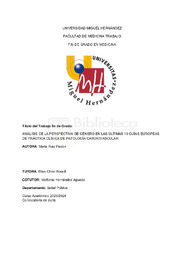Please use this identifier to cite or link to this item:
https://hdl.handle.net/11000/35576Análisis de la perspectiva de género en las últimas 10 guías europeas de práctica clínica de patoología cardiovascular
| Title: Análisis de la perspectiva de género en las últimas 10 guías europeas de práctica clínica de patoología cardiovascular |
| Authors: Ruiz Pastor, María |
| Tutor: Chilet Rosell, Elisa Hernández Aguado, Ildefonso |
| Editor: Universdad Miguel Hernández |
| Department: Departamentos de la UMH::Salud Pública, Historia de la Ciencia y Ginecología |
| Issue Date: 2024-05-13 |
| URI: https://hdl.handle.net/11000/35576 |
| Abstract: Las desigualdades surgidas en condición al género en la atención sanitaria son conocidas desde hace más de tres décadas, si bien la inclusión de sensibilidad en este campo está lejos de haberse alcanzado. Esto se traduce en retrasos diagnósticos, una reducción de la atención sanitaria e incluso un menor acceso a procedimientos invasivos en el caso de las mujeres. Respecto a la patología cardiovascular, ha aumentado notablemente el conocimiento acerca de las diferencias en la aparición y manejo de diversas condiciones entre sexos, si bien no encontramos en la literatura una evaluación extensa sobre las recomendaciones dirigidas a disminuir estas desigualdades. Para incorporar la perspectiva de equidad, es necesario mejorar el conocimiento acerca de los fenómenos estructurales que determinan las desigualdades y la inequidad. Entre ellos, un aspecto concreto de gran impacto en la acción clínica, son las guías de práctica clínica. Es por ello que, mediante la utilización de un instrumento basado en la propuesta de Rico et. al de 2013, este estudio tiene como principal objetivo analizar la perspectiva de género de las 10 últimas guías europeas de práctica clínica de patología cardiovascular publicadas por la Sociedad Europea de Cardiología (ESC). Se ha realizado una base de datos con los resultados de aplicar esta encuesta clasificando en función de la sensibilidad al género cada uno de los ítems considerados en las guías clínicas. El análisis de las guías consideradas evidenció una perspectiva de género insuficiente en términos generales; obteniendo 8 de las 10 guías analizadas un porcentaje global de sensibilidad al género <50%. Sin embargo, la Guía de Práctica Clínica de prevención de enfermedades cardiovasculares, cumplió el 82% de los ítems de la perspectiva de género. El apartado de las guías que mayor consideración tiene respecto al género es la formulación de recomendaciones, si bien es cierto que se detectan sesgos de presunción de homogeneidad en la elaboración de preguntas clínicas, así como universalización de resultados como consecuencia de una sub-representación de la mujer evidente en la mayor proporción de estudios de referencia. Se concluye que es necesario ampliar la consideración de género tanto en investigación como en la inclusión de los resultados a la práctica clínica mediante la elaboración de Guías de Práctica Clínica con un enfoque basado en la equidad, medidas que trasciendan la individualidad y vayan destinadas a disminuir las desigualdades a nivel colectivo y estrategias que permitan evaluar el posterior impacto de estas guías. Gender inequalities in health care have been known for more than three decades, although the inclusion of sensitivity in this field is far from being achieved. In clinical practice, this translates into prehospital delays, a reduction in health care and even less access to invasive procedures in the case of women. As far as cardiovascular pathology is concerned, knowledge about the differences in the appearance and management of various conditions between sexes has increased notably, although it is not exposed in the literature an extensive evaluation of the recommendations aimed at reducing these inequalities. In order to incorporate a perspective based in equity, it is necessary to improve knowledge about the structural features that determine inequalities and inequity. Among these, a specific aspect of great impact on clinical action is the clinical practice guidelines. For this reason, using a survey instrument based in Rico’s et. al suggestion from 2013, the main objective of this study was to analyze the gender perspective of the 10 most recent European clinical practice guidelines on cardiovascular pathology published by the European Society of Cardiology (ESC). The results of this survey were classified according to the gender sensitivity of each of the items considered in the database, which shows that the gender perspective is insufficient in general terms, with 8 of the 10 guidelines analyzed having an overall percentage of gender sensitivity <50%. However, these results are far from the case of the Clinical Practice Guideline on the prevention of cardiovascular diseases, which has shown a gender perspective that complies with 82% of the items considered. On the other hand, the study reveals that the section of the guidelines in which most consideration is given to gender is the formulation of recommendations, although it is true that biases are detected in the presumption of homogeneity in the formulation of clinical questions, as well as universalization of results as a consequence of an evident underrepresentation of women in the greater proportion of reference clinical trials. Therefore, there is a need to broaden the consideration of gender both in research and in the inclusion of the results in clinical practice by means such as the development of Clinical Practice Guidelines with an equity-based approach, measures that transcend individuality and are aimed at reducing inequalities at the collective level, and strategies that allow the subsequent impact of these guidelines to be evaluated. |
| Keywords/Subjects: diferencias de género diferencias de sexo guías de práctica clínica equidad patología cardiovascular |
| Knowledge area: CDU: Ciencias aplicadas: Medicina |
| Type of document: info:eu-repo/semantics/bachelorThesis |
| Access rights: info:eu-repo/semantics/openAccess |
| Appears in Collections: TFG- Medicina |
.png)

